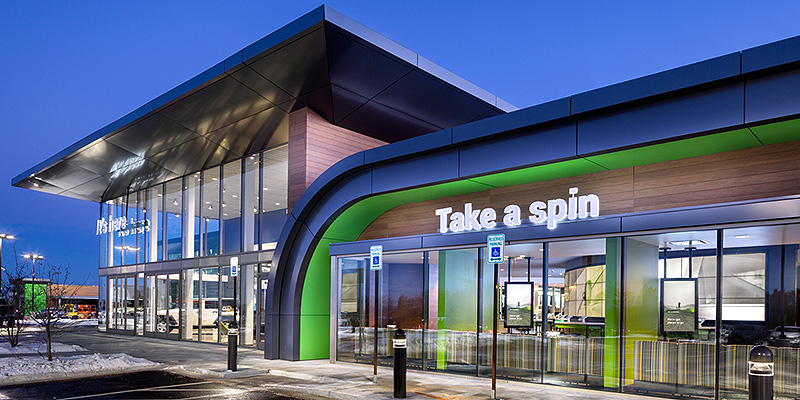And increasingly the largest dealer groups are becoming very vocal about premises demands by their franchises with overt threats that if OEMs go too far then dealers will leave the brand.
American dealers are also finding they can make far more money out of used car warehouse operations at a third of the investment an OEM requires for dealership upgrades.
The branded used car operations are turning out to be very profitable.
There are also growing concerns in America that over-capitalisation of dealerships will see empty car showrooms across the nation in the same way that there are now hundreds of abandoned shopping malls in the States as rents have outstripped commercial reality.

Sonic Automotive cuts back spending on franchise dealership upgrades to focus on its rollout of these new EchoPark used car stores. Others are following the trend
Retailers are also pointing out that there is direct correlation between premises upgrade demands on small dealers and their selling out to bigger dealer groups.
Some point out such forced consolidation may not be in the best interests of the OEMs as the bigger groups get bigger and attain more leverage over the factories.
The latest volley, which came during the National Automobile Dealers Association (NADA) Convention in Las Vegas last week, was from the fifth largest dealership group in America, Sonic Automotive, which has cut back its dealership upgrade investments for this year by more than $100 million.
The timing of the discussion around the NADA Convention coincides with some 30,000 dealers, OEM and motor industry services leaders getting together in the one place to discuss their issues on neutral ground.
The Sonic Automotive leadership team unloaded on OEMs in an interview with Automotive News which puts out daily editions throughout the convention.
Sonic said it would “resist automakers’ demands for grandiose upgrades”.
Jeff Dyke, Sonic’s executive vice president of operations, said the company would no longer be “bullied” into unprofitable premises upgrades.
“We’re just not going to get caught up in the game of building these facilities like we’ve been asked to build in the past,” he said in the interview.
One possible reason for Sonic’s strong stance is that it is getting far greater returns from used car stores for less investment than in an OEM brand.
Sonic is rolling out new, stand-alone used car stores under the EchoPark brand for one third the cost of building a new dealership. It has 10 EchoPark stores and will have 12 by the end of this year.
Mr Dyke said Sonic would focus its capital investment on expanding the network of EchoPark stores rather than on franchised dealership development unless they can see strong returns from dealership upgrades.
Sonic CEO Scott Smith said that it costs $30 million to $50 million to build a dealership. He said it “did not make sense to build a great, big, huge facility and upgrade when at best you hope to break even – even with increased volume.
“Those costs should give all dealers pause,” he told Automotive News.
“The only people who win in that are the manufacturers. The dealer is taking all the risk.”
Mr Smith said dealers of all sizes were affected and that dealers needed to “push back on these manufacturers and hold them accountable because (the auto-makers) have no skin in the game.”
Another major player concerned about poor returns from certain brands is the Penske Automotive Group which is the second largest owner of dealerships in the US and has dealer investments in the UK as well.
He said in January that the group was busy buying used car stores and had cut back its investment in franchise dealerships.
Mr Penske said that all stores, irrespective of brand, would be reviewed this year and if they were not providing an adequate return, and they offered a low chance of being turned around, then the company would divest the store.
He said management was also reviewing the capital expenditure demanded by OEMs and would take a very strategic view of how capital was allocated in that market.
Mr Penske said the company was also attracted to the returns on used car stores where profits were strong. He said a used-only dealership cost about “30 to 40 per cent less” than a premium luxury dealership in the US.
Penske Automotive’s used car brand is CarSense which this year will be expanding beyond its current five used-only stores in the Philadelphia, Pittsburgh and New Jersey areas.
Penske owns CarShop in the UK with five used-only stores and Car People, which has four stores.
Meanwhile, the NADA and the Canadian Automobile Dealers Association have been saying for a number of years that their research shows that upgrade programs are not generating enough increased sales or margins to justify the capital outlays.
Canadian and US dealers spend between $US10 and $US15 billion a year at the behest of the automakers which have rules for the physical appearances of their dealerships that often go as far as setting out what kind of carpet or tile to use on a showroom floor.
Studies by the dealer associations say that covering an investment of $US1 million by a dealership requires an immediate increase in new car sales of about 60 vehicles a year when the costs of borrowing and the profit margins on new cars are taken into account.
These figures are the amounts needed just to recover the investment let alone a positive return.
Among 27 case studies in both countries ranging from an investment of about $US400,000 to one of more than $US20 million, the study found the highest returns on investments came from reconstruction of dilapidated stores.
By John Mellor
